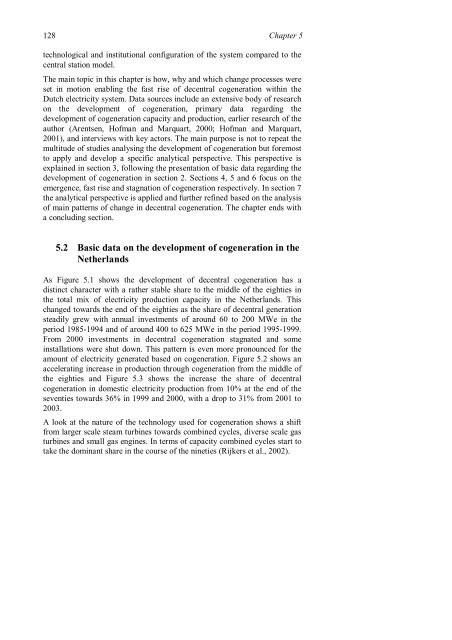Innovation and institutional change: the transition to a sustainable ...
Innovation and institutional change: the transition to a sustainable ...
Innovation and institutional change: the transition to a sustainable ...
Create successful ePaper yourself
Turn your PDF publications into a flip-book with our unique Google optimized e-Paper software.
128 Chapter 5<br />
technological <strong>and</strong> <strong>institutional</strong> configuration of <strong>the</strong> system compared <strong>to</strong> <strong>the</strong><br />
central station model.<br />
The main <strong>to</strong>pic in this chapter is how, why <strong>and</strong> which <strong>change</strong> processes were<br />
set in motion enabling <strong>the</strong> fast rise of decentral cogeneration within <strong>the</strong><br />
Dutch electricity system. Data sources include an extensive body of research<br />
on <strong>the</strong> development of cogeneration, primary data regarding <strong>the</strong><br />
development of cogeneration capacity <strong>and</strong> production, earlier research of <strong>the</strong><br />
author (Arentsen, Hofman <strong>and</strong> Marquart, 2000; Hofman <strong>and</strong> Marquart,<br />
2001), <strong>and</strong> interviews with key ac<strong>to</strong>rs. The main purpose is not <strong>to</strong> repeat <strong>the</strong><br />
multitude of studies analysing <strong>the</strong> development of cogeneration but foremost<br />
<strong>to</strong> apply <strong>and</strong> develop a specific analytical perspective. This perspective is<br />
explained in section 3, following <strong>the</strong> presentation of basic data regarding <strong>the</strong><br />
development of cogeneration in section 2. Sections 4, 5 <strong>and</strong> 6 focus on <strong>the</strong><br />
emergence, fast rise <strong>and</strong> stagnation of cogeneration respectively. In section 7<br />
<strong>the</strong> analytical perspective is applied <strong>and</strong> fur<strong>the</strong>r refined based on <strong>the</strong> analysis<br />
of main patterns of <strong>change</strong> in decentral cogeneration. The chapter ends with<br />
a concluding section.<br />
5.2 Basic data on <strong>the</strong> development of cogeneration in <strong>the</strong><br />
Ne<strong>the</strong>rl<strong>and</strong>s<br />
As Figure 5.1 shows <strong>the</strong> development of decentral cogeneration has a<br />
distinct character with a ra<strong>the</strong>r stable share <strong>to</strong> <strong>the</strong> middle of <strong>the</strong> eighties in<br />
<strong>the</strong> <strong>to</strong>tal mix of electricity production capacity in <strong>the</strong> Ne<strong>the</strong>rl<strong>and</strong>s. This<br />
<strong>change</strong>d <strong>to</strong>wards <strong>the</strong> end of <strong>the</strong> eighties as <strong>the</strong> share of decentral generation<br />
steadily grew with annual investments of around 60 <strong>to</strong> 200 MWe in <strong>the</strong><br />
period 1985-1994 <strong>and</strong> of around 400 <strong>to</strong> 625 MWe in <strong>the</strong> period 1995-1999.<br />
From 2000 investments in decentral cogeneration stagnated <strong>and</strong> some<br />
installations were shut down. This pattern is even more pronounced for <strong>the</strong><br />
amount of electricity generated based on cogeneration. Figure 5.2 shows an<br />
accelerating increase in production through cogeneration from <strong>the</strong> middle of<br />
<strong>the</strong> eighties <strong>and</strong> Figure 5.3 shows <strong>the</strong> increase <strong>the</strong> share of decentral<br />
cogeneration in domestic electricity production from 10% at <strong>the</strong> end of <strong>the</strong><br />
seventies <strong>to</strong>wards 36% in 1999 <strong>and</strong> 2000, with a drop <strong>to</strong> 31% from 2001 <strong>to</strong><br />
2003.<br />
A look at <strong>the</strong> nature of <strong>the</strong> technology used for cogeneration shows a shift<br />
from larger scale steam turbines <strong>to</strong>wards combined cycles, diverse scale gas<br />
turbines <strong>and</strong> small gas engines. In terms of capacity combined cycles start <strong>to</strong><br />
take <strong>the</strong> dominant share in <strong>the</strong> course of <strong>the</strong> nineties (Rijkers et al., 2002).
















